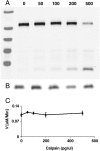No difference in kinetics of tau or histone phosphorylation by CDK5/p25 versus CDK5/p35 in vitro
- PMID: 20133653
- PMCID: PMC2840295
- DOI: 10.1073/pnas.0912718107
No difference in kinetics of tau or histone phosphorylation by CDK5/p25 versus CDK5/p35 in vitro
Abstract
CDK5/p35 is a cyclin-dependent kinase essential for normal neuron function. Proteolysis of the p35 subunit in vivo results in CDK5/p25 that causes neurotoxicity associated with a number of neurodegenerative diseases. Whereas the mechanism by which conversion of p35 to p25 leads to toxicity is unknown, there is common belief that CDK5/p25 is catalytically hyperactive compared to CDK5/p35. Here, we have compared the steady-state kinetic parameters of CDK5/p35 and CDK5/p25 towards both histone H1, the best known substrate for both enzymes, and the microtubule-associated protein, tau, a physiological substrate whose in vivo phosphorylation is relevant to Alzheimer's disease. We show that the kinetics of both enzymes are the same towards either substrate in vitro. Furthermore, both enzymes display virtually identical kinetics towards individual phosphorylation sites in tau monitored by NMR. We conclude that conversion of p35 to p25 does not alter the catalytic efficiency of the CDK5 catalytic subunit by using histone H1 or tau as substrates, and that neurotoxicity associated with CDK5/p25 is unlikely attributable to CDK5 hyperactivation, as measured in vitro.
Conflict of interest statement
The authors declare no conflict of interest.
Figures




Similar articles
-
Cleavage of the cyclin-dependent kinase 5 activator p35 to p25 does not induce tau hyperphosphorylation.Biochem Biophys Res Commun. 2002 Nov 15;298(5):693-8. doi: 10.1016/s0006-291x(02)02543-3. Biochem Biophys Res Commun. 2002. PMID: 12419309
-
Activation of Cdk5/p25 and tau phosphorylation following chronic brain hypoperfusion in rats involves microRNA-195 down-regulation.J Neurochem. 2015 Sep;134(6):1139-51. doi: 10.1111/jnc.13212. J Neurochem. 2015. PMID: 26118667
-
Truncation of CDK5 activator p35 induces intensive phosphorylation of Ser202/Thr205 of human tau.J Biol Chem. 2002 Nov 15;277(46):44525-30. doi: 10.1074/jbc.M207426200. Epub 2002 Sep 10. J Biol Chem. 2002. PMID: 12226093
-
The regulation of cyclin-dependent kinase 5 activity through the metabolism of p35 or p39 Cdk5 activator.Neurosignals. 2003 Sep-Oct;12(4-5):221-9. doi: 10.1159/000074624. Neurosignals. 2003. PMID: 14673209 Review.
-
Peptides derived from Cdk5 activator p35, specifically inhibit deregulated activity of Cdk5.Biotechnol J. 2007 Aug;2(8):978-87. doi: 10.1002/biot.200700057. Biotechnol J. 2007. PMID: 17526058 Review.
Cited by
-
Morphine and HIV-1 Tat interact to cause region-specific hyperphosphorylation of tau in transgenic mice.Neurosci Lett. 2021 Jan 10;741:135502. doi: 10.1016/j.neulet.2020.135502. Epub 2020 Nov 14. Neurosci Lett. 2021. PMID: 33202259 Free PMC article.
-
Quantum capacitance-limited MoS2 biosensors enable remote label-free enzyme measurements.Nanoscale. 2019 Sep 7;11(33):15622-15632. doi: 10.1039/c9nr03171e. Epub 2019 Aug 13. Nanoscale. 2019. PMID: 31407757 Free PMC article.
-
Cdk5 activity in the brain - multiple paths of regulation.J Cell Sci. 2014 Jun 1;127(Pt 11):2391-400. doi: 10.1242/jcs.147553. J Cell Sci. 2014. PMID: 24879856 Free PMC article. Review.
-
p10, the N-terminal domain of p35, protects against CDK5/p25-induced neurotoxicity.Proc Natl Acad Sci U S A. 2012 Dec 4;109(49):20041-6. doi: 10.1073/pnas.1212914109. Epub 2012 Nov 14. Proc Natl Acad Sci U S A. 2012. PMID: 23151508 Free PMC article.
-
The Beta-amyloid protein of Alzheimer's disease: communication breakdown by modifying the neuronal cytoskeleton.Int J Alzheimers Dis. 2013;2013:910502. doi: 10.1155/2013/910502. Epub 2013 Dec 12. Int J Alzheimers Dis. 2013. PMID: 24416616 Free PMC article. Review.
References
-
- Ishiguro K, et al. A serine/threonine proline kinase activity is included in the tau protein kinase fraction forming a paired helical filament epitope. Neurosci Lett. 1991;128:195–8. - PubMed
-
- Ishiguro K, et al. Tau protein kinase I converts normal tau protein into A68-like component of paired helical filaments. J Biol Chem. 1992;267:10897–901. - PubMed
-
- Lew J, Beaudette K, Litwin CM, Wang JH. Purification and characterization of a novel proline-directed protein kinase from bovine brain. J Biol Chem. 1992;267:13383–90. - PubMed
-
- Lew J, Winkfein RJ, Paudel HK, Wang JH. Brain proline-directed protein kinase is a neurofilament kinase which displays high sequence homology to p34cdc2. J Biol Chem. 1992;267:25922–6. - PubMed
-
- Lew J, Wang JH. Neuronal cdc2-like kinase. Trends Biochem Sci. 1995;20:33–7. - PubMed
Publication types
MeSH terms
Substances
Grants and funding
LinkOut - more resources
Full Text Sources
Molecular Biology Databases
Research Materials

